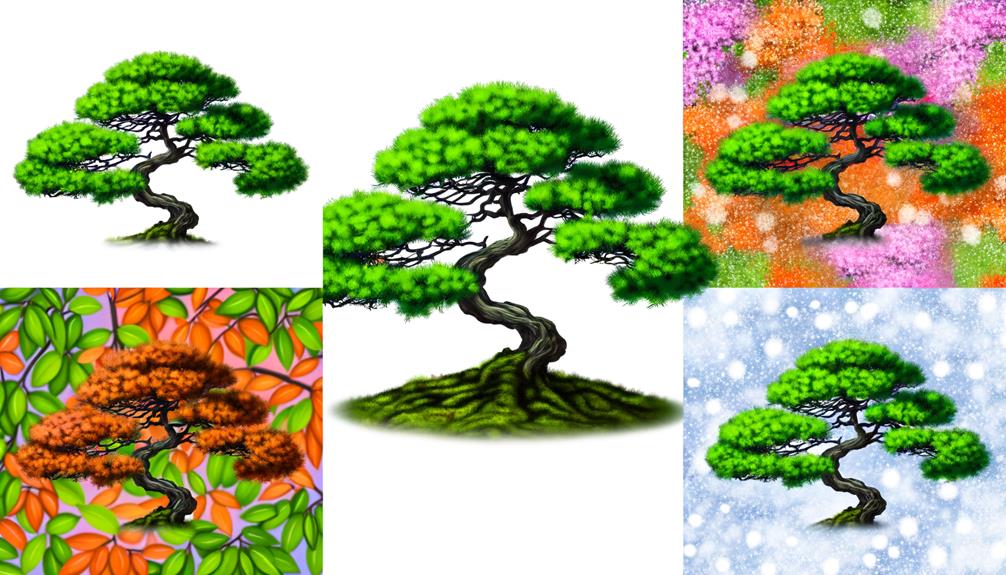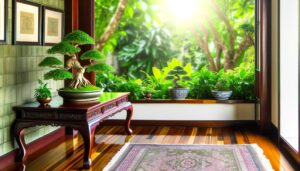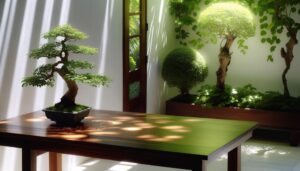Mastering Buxus Harlandii Bonsai: A Care Guide
Proper care of a Buxus Harlandii bonsai involves precise management of light, water, soil, pruning, repotting, and pest control. Secure 4-6 hours of direct sunlight daily, preferably morning sun, and rotate regularly for even exposure.
Maintain soil moisture, avoiding waterlogging, and use a moisture meter for accuracy. Employ a well-draining soil mix and apply a balanced N-P-K fertilizer during the growing season.
Prune and shape seasonally, and repot early spring with careful root pruning. Vigilance against pests like spider mites is vital.
Detailed seasonal care—adjusting for temperature and growth cycles—is necessary for prime health and aesthetics. Explore further for thorough insights.

Key Takeaways
- Ensure 4-6 hours of direct sunlight daily, ideally morning sun, for optimal growth.
- Maintain consistent watering, keeping the top inch of soil slightly damp, adjusting frequency seasonally.
- Use well-draining soil and apply a slow-release fertilizer rich in nitrogen, phosphorus, and potassium during the growing season.
- Perform seasonal pruning and periodic trimming to maintain bonsai shape and health.
- Monitor for pests and diseases, ensuring well-draining soil and clean pruning tools to prevent infestations and pathogen spread.
Light Requirements

Buxus Harlandii bonsai requires a minimum of four to six hours of direct sunlight daily to maintain peak health and growth. Best light conditions involve placing the bonsai in a location with unobstructed morning sun, which helps prevent excessive heat stress during midday.
Indoor cultivation necessitates placement near south-facing windows or the use of full-spectrum grow lights to mimic natural sunlight. Monitor the leaf coloration and growth patterns; insufficient light results in elongated internodes and pale leaves, indicating etiolation.
Additionally, regularly rotate the bonsai to ensure even exposure, promoting uniform foliage density. Proper light management is essential, as it directly influences photosynthetic efficiency, overall vigor, and resilience of the Buxus Harlandii bonsai.
Watering Schedule
To guarantee peak hydration, establish a consistent watering schedule tailored to the Buxus Harlandii bonsai's specific needs, taking into consideration factors such as soil composition, container size, and environmental conditions.
Begin by evaluating the moisture level of the soil daily; the top inch should remain slightly damp but not waterlogged. Early morning watering is ideal to minimize evaporation and provide hydration throughout the day. Ensure even water distribution to prevent root rot and facilitate proper drainage.
Adjust frequency during seasonal changes, increasing in warmer months and decreasing during cooler periods. To maintain balance, consider using a moisture meter for accuracy. Avoid drastic fluctuations in soil moisture to support the bonsai's overall health and vitality.
Soil and Fertilization

For best growth, Buxus Harlandii bonsai requires well-draining soil with a composition of 40% organic material, 30% akadama, and 30% pumice.
Using a balanced, slow-release fertilizer rich in nitrogen, phosphorus, and potassium will guarantee the plant obtains necessary nutrients.
It is essential to fertilize during the growing season, usually from early spring to late summer, to encourage robust development.
Ideal Soil Composition
A well-draining, loamy soil with a slightly acidic to neutral pH is necessary for the best growth and health of Buxus Harlandii bonsai. The soil composition should be carefully balanced to provide ideal aeration and moisture retention.
Key components for an ideal soil mix include:
- Akadama: A high-quality, granular clay that enhances drainage and aeration.
- Pumice: Helps retain some moisture while improving soil structure and root health.
- Lava Rock: Aids in proper drainage, preventing root rot and compacting.
- Organic Compost: Supplies essential nutrients and enhances microbial activity for sustained plant health.
These elements collectively create a conducive environment for robust root development and overall wellness. Maintaining this precise soil composition is essential for the sustained vigor and aesthetic appeal of your Buxus Harlandii bonsai.
Nutrient-Rich Fertilizers
Selecting the appropriate nutrient-rich fertilizers is crucial for promoting the optimal growth and overall health of Buxus Harlandii bonsai. Choose a balanced, slow-release fertilizer with an N-P-K ratio of around 10-10-10. This guarantees a consistent supply of nitrogen, phosphorus, and potassium, essential for foliage development, root growth, and overall well-being.
Apply the fertilizer every 4-6 weeks during the growing season, from early spring to late summer. Avoid excessive fertilization, as it can result in root burn and nutrient imbalances. Natural options, such as fish emulsion or compost tea, can also be advantageous, providing micronutrients and improving soil microbial activity.
Always water the bonsai thoroughly before and after fertilization to prevent root damage.
Pruning Techniques
Pruning Techniques for Buxus Harlandii bonsai involve precise shaping and regular maintenance to encourage balanced growth and desired aesthetics. Seasonal pruning is essential, with major structural cuts recommended in early spring to facilitate robust new growth.
Additionally, periodic trimming throughout the growing season maintains the bonsai's form and health, while mitigating excessive foliage density.
Shaping and Maintenance
Mastering the art of shaping Buxus Harlandii bonsai requires a deep understanding of strategic branch selection and precise cutting methods to enhance both aesthetic appeal and structural strength.
To achieve an ideal form, consider the following steps:
- Primary Branch Selection: Identify and prioritize primary branches that establish the basic structure. Eliminate any competing branches to maintain a clean silhouette.
- Secondary Branch Development: Concentrate on developing secondary branches that emerge from primary ones, ensuring balanced growth and proper spacing.
- Leaf Pruning: Regularly trim leaves to encourage light penetration and airflow, which is essential for photosynthesis and overall plant health.
- Wiring Techniques: Apply wiring to guide branch direction and shape. Use suitable gauge wire and make sure not to restrict the branch, allowing for natural growth.
These techniques are fundamental in shaping a resilient and visually appealing Buxus Harlandii bonsai.
Seasonal Pruning Tips
For best growth and aesthetic refinement, seasonal pruning of Buxus Harlandii bonsai should be meticulously timed and executed to align with the plant's natural growth cycles.
Spring is ideal for structural pruning, as the plant enters its active growth phase. Use sharp, sterilized shears to remove dead or undesired branches, encouraging new growth.
Summer requires maintenance pruning to manage shape and density; avoid heavy cuts to prevent stress.
In autumn, light trimming helps prepare the bonsai for dormancy, focusing on removing weak or crossing branches.
Winter pruning should be minimal, as the plant's growth is dormant. Always consider branch thickness and angle, employing precise cuts to maintain the bonsai's health and visual harmony.
Repotting Guidelines

Repotting Buxus harlandii bonsai requires meticulous attention to timing, substrate composition, and root pruning techniques to guarantee growth and health. Ideally, repotting should be undertaken in early spring before the onset of vigorous growth.
The substrate must be well-draining; a mixture of akadama, pumice, and lava rock in a 1:1:1 ratio is recommended. Root pruning should be executed with precision to avoid stress, ensuring only one-third of the root ball is trimmed.
Follow these steps:
- Timing: Undertake repotting in early spring.
- Substrate: Use a well-draining mix of akadama, pumice, and lava rock.
- Root Pruning: Trim no more than one-third of the root ball.
- Aftercare: Keep the bonsai in a shaded area and water moderately until it acclimates.
Pest and Disease Management
Maintaining the health of your Buxus harlandii bonsai also requires attentive pest and disease management, focusing on common issues such as boxwood leafminer, spider mites, and root rot.
Regular inspection is essential; examine leaves for signs of yellowing or stippling, indicative of spider mite infestation. Employ miticides or horticultural oils for control. For boxwood leafminer, look for blistered leaf surfaces and use systemic insecticides.
To prevent root rot, guarantee well-draining soil and avoid overwatering. Fungicides can be applied as a preventive measure. Clean pruning tools with alcohol to prevent pathogen transmission.
Implementing these strategies will help maintain the strength of your bonsai, making sure it remains healthy and robust.
Seasonal Care Tips

Seasonal care for Buxus harlandii bonsai involves adjusting watering schedules, pruning practices, and protection measures to accommodate the unique climatic conditions of each season. To promote excellent health and aesthetic appeal, follow these expert guidelines:
- Spring: Increase watering frequency as temperatures rise and new growth begins. Trim to shape and remove any winter damage.
- Summer: Provide shade during peak sunlight hours to prevent leaf scorch. Water consistently, avoiding periods of dryness.
- Autumn: Gradually reduce watering and trim to prepare for dormancy. Check for pests and diseases before winter.
- Winter: Shield from freezing temperatures by moving indoors or providing insulation. Minimize watering, ensuring soil remains slightly moist.
Following these seasonal protocols will encourage a vigorous and visually pleasing Buxus harlandii bonsai.
Conclusion
In sum, the Buxus harlandii bonsai, despite its seemingly delicate appearance and meticulous requirements, thrives under a stringent regimen of light, water, soil, and pruning techniques.
Ironically, this intricate care routine ultimately rewards the diligent gardener with a resilient and aesthetically pleasing specimen.
By adhering to these expert guidelines, one would discover that the complexities of bonsai cultivation are, in fact, a tribute to the beauty and resilience inherent in this ancient horticultural art.




